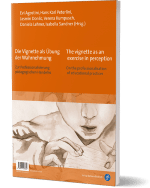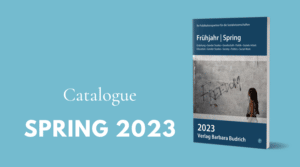Die Vignette als Übung der Wahrnehmung / The vignette as an exercise in perception
Zur Professionalisierung pädagogischen Handelns / On the professionalisation of educational practices
edited by Evi Agostini, Hans Karl Peterlini, Jasmin Donlic, Verena Kumpusch, Daniela Lehner and Isabella Sandner
This is a bilingual title – The book contains a German-language and an English-language version. (It is also available in German-Italian and in English-Greek.)
About the book
Pedagogical work requires the willingness to engage with new situations and with people in their diversity. This book does not offer any simple recipes, but a gentle approach to important steps towards professionalisation in the teaching profession. These lead via an open attitude of perception and the inclusion of corporeality to an insight into how learning and teaching processes can be understood in a new or different way. With vignettes and examples from different pedagogical fields, the theoretical concepts are presented and reflected on their application.
Dear editors, what is the volume “Die Vignette als Übung der Wahrnehmung / The vignette as an exercise in perception” about?
The aim of the book is to encourage educators to approach the children, young people and adults in an attitude of open perception. The book sees itself as a contribution to participatory, active professionalisation and accompanies the reader on this path in several steps. For this purpose, it also provides them with the instrument of the “vignette”.
You use vignettes in your publication to present concepts and reflect on their application. Would you give us an example of this?
Vignettes are short, dense descriptions of what is happening or has happened in the field of education – whether school, youth centre, adult education. As authors, we are guided by what “touches” the attention, i.e. what attracts it. We pay particular attention to physical expression, which is often overlooked: How does a child move, how does he or she sit, how do young people interact with their hands when they stand, what is the tone of voice. So, when we perceive a certain situation, it is not only the content, what is said, that is in the foreground. We condense these perceptions in the vignettes. When writing, we take care to avoid interpretations, evaluations and classifications and to describe as precisely as possible what we have seen, heard and experienced. This corresponds to the basic phenomenological attitude of being open to what we can perceive of the world and the events in it with our senses. There are many vivid examples of this in our book.
Which new perspectives does vignette research open up for educational research and practice?
Educators, like all people, are quick to have simple patterns of interpretation at hand for situations they are familiar with – they believe they know their clients and are therefore easily tempted to categorise those entrusted to their care. This is certainly helpful, but often leads to categorisations such as “talented”, “less talented”, “hard-working”, “not hard-working”, “always disturbing”, “conspicuous” or “never paying attention”.
Such rigid categorisation overlooks much of what these children, young people and adults are otherwise. The same applies to situations in the educational field: we usually interpret them through the lens of our previous experiences. In doing so, we exclude many possibilities of interpretation. That is why we talk about the “exercise” of perception. We have to learn again not to skip the exact looking, guiding, empathising by quick and often rash interpretations, but to take the time to let the situation, the concrete person, if possible even before the categorisation, simply have an effect on us and look, listen, empathise with what is actually happening. This often opens up completely new perspectives on supposedly long-settled situations and so-called difficult cases. Potentials become visible as well as alternative ways of acting
Your book was published this month in different multi-lingual editions: A German-English edition, an English-Greek edition and a German-Italian edition. Why did you decide to publish the book not only in different languages, but in multi-lingual editions?
This publication emerged from the “ProLernen” project, in which universities and teacher training colleges in Austria, Germany, Switzerland-Liechtenstein, Italy/South Tyrol and Greece worked together thanks to Erasmus+ funding. It made sense for us to offer our approach and the theory behind it to the teachers in these countries in their language. English was a concern for us anyway, as vignette research is now receiving international attention, from South Africa to Asia.
How did you approach the translation of the books? Were there any particular challenges in translating the concept?
Yes, translating the phenomenological approach was a challenge. It would not have been possible without the colleagues involved in the project in the respective language areas. The difficulty lay above all in the translation of the terminology. Phenomenology was founded by the German-speaking philosopher Edmund Husserl, so the basic literature was originally written in German. In the meantime, of course, there is phenomenological literature in all languages, but care had to be taken to ensure that certain terms were translated in such a way that they could be understood by the reader. The book is not only meant to be read, we also understand it as a stimulus and invitation to engage in the exercise of perception with vignettes.
The editors:
 Evi Agostini is Associate Professor at the Centre for Teacher Education and the Faculty of Philosophy and Educational Science at the University of Vienna. She received her PhD in General Pedagogy from the Free University of Bozen-Bolzano in 2015 and her Venia Docendi in Educational Science from the University of Innsbruck in 2019. Evi Agostini teaches courses on learning theories, research methods and anthropological pedagogy in Austria, Germany and Italy and is active in the field of professional learning of teachers and school leaders especially in Austria, Germany and Switzerland. She was a research fellow at Hebrew University and Beit Berl College in Israel and is the coordinator of the international phenomenological vignette and anecdote research network (VignA).
Evi Agostini is Associate Professor at the Centre for Teacher Education and the Faculty of Philosophy and Educational Science at the University of Vienna. She received her PhD in General Pedagogy from the Free University of Bozen-Bolzano in 2015 and her Venia Docendi in Educational Science from the University of Innsbruck in 2019. Evi Agostini teaches courses on learning theories, research methods and anthropological pedagogy in Austria, Germany and Italy and is active in the field of professional learning of teachers and school leaders especially in Austria, Germany and Switzerland. She was a research fellow at Hebrew University and Beit Berl College in Israel and is the coordinator of the international phenomenological vignette and anecdote research network (VignA).
 Hans Karl Peterlini is Professor of General Education and Intercultural Education at the University of Klagenfurt. He studied psychoanalytic pedagogy in Innsbruck, received his doctorate in the fields of general education and social pedagogy at the Free University of Bolzano, and in 2014 obtained the venia docendi for educational sciences and learning research at the University of Innsbruck with his habilitation thesis “Learning and Power”. His teaching and research focuses on transformation processes through personal and collective learning, the coexistence of majorities and minorities in ethnicised and migrant societies, and global citizenship education as an integrating approach for globally and socially sensitive education. Peterlini holds the UNESCO Chair Global Citizenship Education – Culture of Diversity and Peace at the University of Klagenfurt.
Hans Karl Peterlini is Professor of General Education and Intercultural Education at the University of Klagenfurt. He studied psychoanalytic pedagogy in Innsbruck, received his doctorate in the fields of general education and social pedagogy at the Free University of Bolzano, and in 2014 obtained the venia docendi for educational sciences and learning research at the University of Innsbruck with his habilitation thesis “Learning and Power”. His teaching and research focuses on transformation processes through personal and collective learning, the coexistence of majorities and minorities in ethnicised and migrant societies, and global citizenship education as an integrating approach for globally and socially sensitive education. Peterlini holds the UNESCO Chair Global Citizenship Education – Culture of Diversity and Peace at the University of Klagenfurt.
 You can purchase the book as a print book or e-book in our shop:
You can purchase the book as a print book or e-book in our shop:
Die Vignette als Übung der Wahrnehmung / The vignette as an exercise in perception
edited by Evi Agostini, Hans Karl Peterlini, Jasmin Donlic, Verena Kumpusch, Daniela Lehner and Isabella Sandner
Portrait photos: Hans Karl Peterlini: privat; Evi Agostini: Universität Wien/Joseph Krpelan

